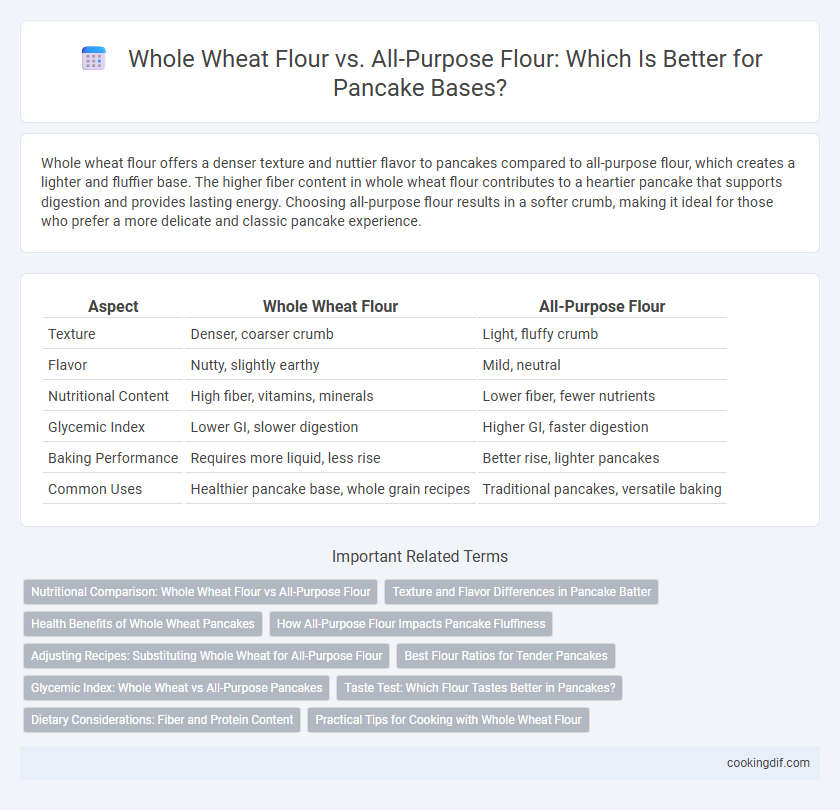Whole wheat flour offers a denser texture and nuttier flavor to pancakes compared to all-purpose flour, which creates a lighter and fluffier base. The higher fiber content in whole wheat flour contributes to a heartier pancake that supports digestion and provides lasting energy. Choosing all-purpose flour results in a softer crumb, making it ideal for those who prefer a more delicate and classic pancake experience.
Table of Comparison
| Aspect | Whole Wheat Flour | All-Purpose Flour |
|---|---|---|
| Texture | Denser, coarser crumb | Light, fluffy crumb |
| Flavor | Nutty, slightly earthy | Mild, neutral |
| Nutritional Content | High fiber, vitamins, minerals | Lower fiber, fewer nutrients |
| Glycemic Index | Lower GI, slower digestion | Higher GI, faster digestion |
| Baking Performance | Requires more liquid, less rise | Better rise, lighter pancakes |
| Common Uses | Healthier pancake base, whole grain recipes | Traditional pancakes, versatile baking |
Nutritional Comparison: Whole Wheat Flour vs All-Purpose Flour
Whole wheat flour contains higher fiber, vitamins, and minerals compared to all-purpose flour, supporting better digestion and overall health. Its richer nutrient profile includes increased protein, iron, magnesium, and B vitamins, which contribute to sustained energy release. All-purpose flour, while refined and lower in nutrients, offers a lighter texture but lacks the whole grain benefits found in whole wheat flour.
Texture and Flavor Differences in Pancake Batter
Whole wheat flour creates a denser, heartier pancake texture with a slightly nutty flavor, while all-purpose flour yields lighter, fluffier pancakes with a more neutral taste. The higher fiber content in whole wheat flour absorbs more liquid, resulting in a thicker batter and chewier bite, whereas all-purpose flour produces a smoother, more tender batter. Flavor-wise, whole wheat adds complexity and a mild earthiness, contrasting with the mild, sweet notes typical of all-purpose flour-based pancakes.
Health Benefits of Whole Wheat Pancakes
Whole wheat flour provides more dietary fiber, vitamins, and minerals compared to all-purpose flour, making whole wheat pancakes a healthier option for maintaining digestive health and sustaining energy levels. The higher protein content in whole wheat flour supports muscle repair and growth, while its lower glycemic index helps regulate blood sugar. Choosing whole wheat pancakes promotes better heart health and weight management due to increased nutrient density and slower carbohydrate absorption.
How All-Purpose Flour Impacts Pancake Fluffiness
All-purpose flour contributes to pancake fluffiness by providing a moderate protein content that develops enough gluten to create a tender yet airy texture. Its balanced gluten formation allows pancakes to rise well, trapping air bubbles that result in a soft, light crumb. Compared to whole wheat flour, which contains more fiber and denser bran, all-purpose flour yields a fluffier, less dense pancake base.
Adjusting Recipes: Substituting Whole Wheat for All-Purpose Flour
Substituting whole wheat flour for all-purpose flour in pancake recipes requires adjusting the liquid content, as whole wheat flour absorbs more moisture and produces denser batter. Reducing the amount of whole wheat flour to 75% of the all-purpose flour quantity can help maintain a lighter texture while preserving the nutritional benefits of whole grains. Incorporating additional leavening agents, such as baking powder or baking soda, enhances fluffiness and prevents the pancakes from becoming too heavy.
Best Flour Ratios for Tender Pancakes
Using whole wheat flour in pancakes increases fiber and nutrient content but can result in a denser texture compared to all-purpose flour. A blend of 50% whole wheat flour and 50% all-purpose flour achieves the best balance for tender, fluffy pancakes. Adjusting the ratio with 25% whole wheat to 75% all-purpose flour yields a lighter texture while enhancing flavor and nutrition.
Glycemic Index: Whole Wheat vs All-Purpose Pancakes
Whole wheat flour pancakes have a lower glycemic index (GI) compared to all-purpose flour pancakes, resulting in slower blood sugar spikes and prolonged energy release. The higher fiber content in whole wheat flour contributes to this reduced GI, promoting better blood glucose control. Choosing whole wheat flour for pancakes supports improved metabolic health and sustained satiety.
Taste Test: Which Flour Tastes Better in Pancakes?
Whole wheat flour offers a nuttier, denser texture compared to the lighter, fluffier pancakes made with all-purpose flour. Taste tests reveal that whole wheat pancakes have a richer, more complex flavor, appealing to those who prefer a hearty bite. All-purpose flour, however, creates a milder taste with a softer crumb, ideal for classic, tender pancakes.
Dietary Considerations: Fiber and Protein Content
Whole wheat flour offers higher dietary fiber and protein content compared to all-purpose flour, supporting better digestive health and prolonged satiety. The increased fiber in whole wheat flour aids in regulating blood sugar levels and promoting cardiovascular health. Pancakes made with whole wheat flour provide a more nutrient-dense option, ideal for those seeking to boost their daily fiber and protein intake.
Practical Tips for Cooking with Whole Wheat Flour
Whole wheat flour contains more fiber and nutrients than all-purpose flour, which can affect pancake texture by making it denser and heartier. To achieve lighter pancakes, combine whole wheat flour with baking powder and consider adding a bit more liquid since whole wheat absorbs moisture faster. Practical tips include allowing the batter to rest for 5-10 minutes before cooking to improve elasticity and using lower heat to prevent burning while ensuring even cooking.
Whole wheat flour vs all-purpose flour for base Infographic

 cookingdif.com
cookingdif.com